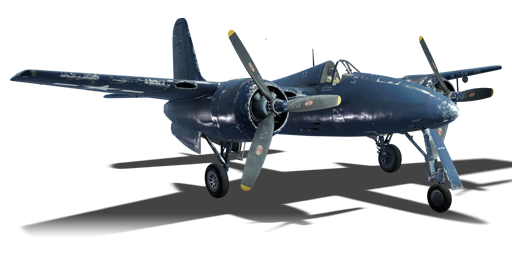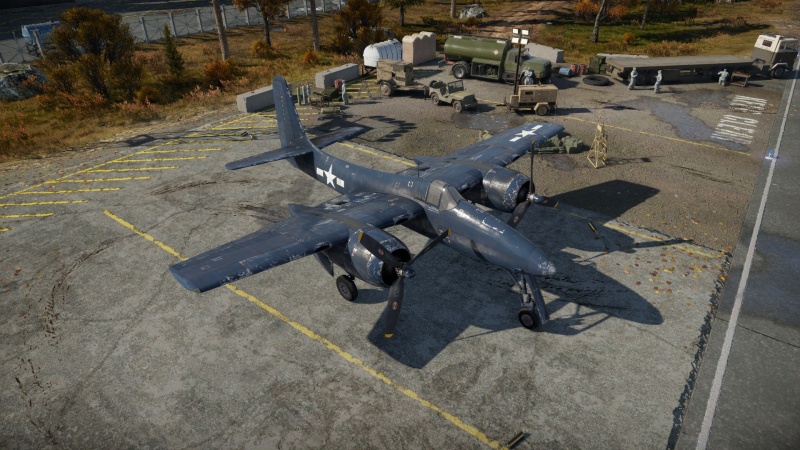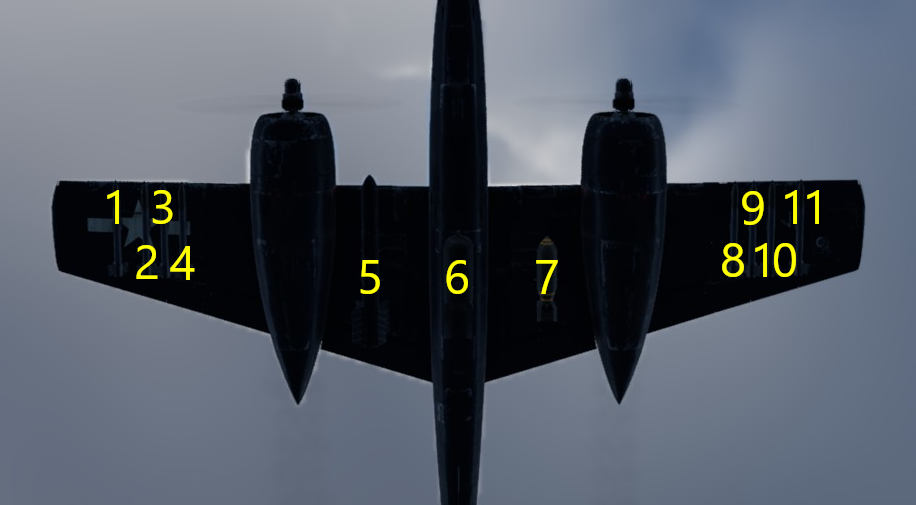F7F-3
| This page is about the gift American naval fighter F7F-3. For the regular version, see F7F-1. |
Contents
Description
The F7F-3 Tigercat is a premium gift rank IV American twin-engine fighter with a battle rating of 6.7 (AB/SB) and 6.3 (RB). It was introduced during Update 1.61 "Road to Glory" in the Operation S.U.M.M.E.R. event of 2016.
The F7F-3 Tigercat is further development of the US Navy twin-engine fighter, the F7F-1. The third modification is equipped with more powerful engines which allowed for the installation of unguided rockets and which included three Tiny Tims, which are effective not only against ships, but also enemy bases. Although the original F7F could reach a very high speed for a twin-engine fighter, this new machine accelerates even faster both in level flight and in a dive, which makes it an excellent aircraft for "Boom and Zoom" tactics. Like the original Tigercat, the F7F-3 has four 20 mm guns AN/M2 and four 12.7 mm M2 Browning machine guns - a powerful arsenal with a fire rate of almost 8 kg of lead per second!
General info
Flight performance
The F7F-3 is exceptionally fast at low and medium altitude, but it gets mediocre after reaching 7,000 m altitude and above. Climb rate is also very good since it is an interceptor, it is one of the best climbing propeller-driven fighters in the game, but similarly to the level speed, at high altitude it gets worse compared to the other fighters like the Lightning or Thunderbolt. A very good power to weight ratio makes its acceleration in level flight and diving great. Manoeuvrability is quite bad, it is comparable to some jets like the F-80, at low and medium speed it will not be able to win any dogfight and the high speed G load is very low, up to 8G, roll rate is very low, sometimes it can make the aiming a little hard. Stalling speed is very high, the plane can start spinning even at high speed during the attempt to perform a tight turn, stalling itself is not violent, the F7F does not start to spin right after reaching and exceeding the critical angle of attack, it takes up to two seconds for this to happen.
| Characteristics | Max Speed (km/h at 4,877 m) |
Max altitude (metres) |
Turn time (seconds) |
Rate of climb (metres/second) |
Take-off run (metres) | |||
|---|---|---|---|---|---|---|---|---|
| AB | RB | AB | RB | AB | RB | |||
| Stock | 671 | 652 | 12800 | 26.4 | 27.4 | 20.0 | 20.0 | 444 |
| Upgraded | 751 | 708 | 23.7 | 25.0 | 33.3 | 25.5 | ||
Details
| Features | ||||
|---|---|---|---|---|
| Combat flaps | Take-off flaps | Landing flaps | Air brakes | Arrestor gear |
| ✓ | ✓ | ✓ | X | ✓ |
| Limits | ||||||
|---|---|---|---|---|---|---|
| Wings (km/h) | Gear (km/h) | Flaps (km/h) | Max Static G | |||
| Combat | Take-off | Landing | + | - | ||
| 835.14 | 463 | 455 | 425 | 277 | ~10 | ~8 |
| Optimal velocities (km/h) | |||
|---|---|---|---|
| Ailerons | Rudder | Elevators | Radiator |
| < 466 | < 450 | < 555 | > 315 |
| Compressor (RB/SB) | ||
|---|---|---|
| Optimal altitude | Setting 1 | |
| 850 m | 2,100 hp | 100% Engine power |
| 0 m | 2,590 hp | WEP Engine power |
| Optimal altitude | Setting 2 | |
| 5,340 m | 1,700 hp | 100% Engine power |
| 4,500 m | 2,100 hp | WEP Engine power |
Survivability and armour
- 60 mm Bulletproof glass - Pilot's windscreen
- 9.5 mm Steel - Plate in the nose
- 6.35 mm Aluminium Alloy - Fore cockpit armour plate
- 12.7 mm Steel - Plate behind pilot's seat
- 6.35 mm Steel - Oil cooling system protection
Modifications and economy
Armaments
Offensive armament
The F7F-3 is armed with:
- 4 x 20 mm M3 cannons, wing-mounted (200 rpg = 800 total)
- 4 x 12.7 mm M2 Browning machine guns, nose-mounted (400 rpg = 1,600 total)
Suspended armament
The F7F-3 can be outfitted with the following ordnance:
| 1 | 2 | 3 | 4 | 5 | 6 | 7 | 8 | 9 | 10 | 11 | ||
|---|---|---|---|---|---|---|---|---|---|---|---|---|
| 500 lb AN-M64A1 bombs | 1 | 1 | ||||||||||
| 1,000 lb AN-M65A1 bombs | 1 | 1 | 1 | |||||||||
| 1,600 lb AN-Mk 1 bombs | 1 | |||||||||||
| 2,000 lb AN-M66A2 bombs | 1 | |||||||||||
| HVAR rockets | 1 | 1 | 1 | 1 | 1 | 1 | 1 | 1 | ||||
| Tiny Tim rockets | 1 | 1 | 1 | |||||||||
| Type A Mark I mines | 1 | 1 | 1 | |||||||||
| Maximum permissible loadout weight: 2,100 kg | ||||||||||||
| Default weapon presets | |
|---|---|
| |
Usage in battles
The F7F-3 is one of the best American interceptors, it possesses an above average climb rate, overwhelming armament and is quite stable. The climb rate allows it to get above everything enemy fighters or in the worst scenario at the same altitude, but then its armament can be used to push down the enemy fighters and force them to run or go for the head on attack, which in most cases the F7F will win, all its guns are place close to each other near the center of the plane, the gun convergence issues do not affect this plane and it possible to aim accurately even at the long distance, before the enemy gets close, a very high bullet velocity of shells for the guns also is helping a lot. After getting above the enemy the F7F can get very deadly because of its acceleration and energy retention, in most cases it will need only one approach to take out the enemy plane and trying to follow it in zoom climb can be an issue. When the F7F is below the enemy it can get hard, low turn and roll rate and also the fact that the plane is a large target will not help when the player is trying to avoid enemy attacks, although the superior dive acceleration and speed can be used to get away and then force the enemy to commit a head on attack. Dogfighting against any type of plane should be always avoided, an encounter at low speed will always end up very badly for the F7F because of its lacking manoeuvrability.
Against German planes the player should always try to get the altitude advantage and use Boom and Run techniques, committing to head on can be a little risky since most of German planes has good offensive armament, very often comparable to the F7F. When they are above it could be possible to use the dive speed to get away from the Bf 109, their max allowed speed is lower, those fighters are also way slower from low to medium altitude. It can get harder in a fight against the Fw 190D series, they are considered bad at turning but the F7F would be equally good at turning at best, outturning will also be an issue, the Fw 190's wing break speed is higher, the only level speed difference in favour of the F7F over them is at low altitude.
Tactics used against the Italians should be similar since they have similar equipment, but compared to the Bf 109 series all their planes have very high wing break speed, trying to outrun them in a level flight is a better solution after getting into any trouble against them, most of their fighters are 80 km/h slower, sometimes the level speed difference is even higher.
The Japanese fighters have worse armament, going for the head on situation against them is always a good idea, specially since the F7F is a quite durable plane, when they get to the higher altitude the only way to not get shot down is to run, dogfighting is not an option, even against their heavy fighters.
Manual Engine Control
| MEC elements | ||||||
|---|---|---|---|---|---|---|
| Mixer | Pitch | Radiator | Supercharger | Turbocharger | ||
| Oil | Water | Type | ||||
| Controllable | Controllable Auto control available |
Controllable Auto control available |
Controllable Auto control available |
Separate | Controllable 2 gears |
Not controllable |
Pros and cons
Pros:
- Very high climb rate
- Great dive speed
- Overwhelming armament with lots of ammunition
- Good acceleration
- Very rugged
- Very fast, can catch a number of jets
- Lots of payload options
Cons:
- Mediocre manoeuvrability
- Large target
History
The Grumman company continued to work on the F7F after it entered service. The third variant of the aircraft was a very deep modernization of the original, although visually the only difference was a bigger tail section (this resulted in a much better stability during flight). On the other hand, the biggest change was the introduction of the more powerful "Pratt & Whitney" R-2800-34W engines with a power output of 2,100 HP, which allowed for better flight characteristics in the Tigercat at high altitude.
Acceleration and climb rate increased, while the powerful weapons in the nose of the aircraft, consisting of four 20 mm guns and four 12.7 mm machine guns, remained. This fighter could carry rockets, which made it more universal and effective in attacking both ground and sea targets.
This aircraft was in production from March 1945 till June 1946 and during this time 250 units were built
Media
- Skins
See also
- Related development
External links
- [Special] Operation S.U.M.M.E.R.
- [News] F7F-3 Tigercat
- Official data sheet - more details about the performance
| Grumman Aircraft Engineering Corporation | |
|---|---|
| Fighters | |
| F3F | F3F-2 · Galer's F3F-2 |
| F4F Wildcat | F4F-3 · F4F-4 |
| XF5F Skyrocket | XF5F · XP-50 |
| F6F Hellcat | F6F-5 · F6F-5N |
| F7F Tigercat | F7F-1 · F7F-3 |
| F8F Bearcat | F8F-1 · F8F-1B |
| Jet Fighters | |
| F9F Panther/Cougar | F9F-2 · F9F-5 · F9F-8 |
| F-11 Tiger | F11F-1 |
| F-14 Tomcat | F-14A Early · F-14B |
| Jet Strike Aircraft | |
| A-6 Intruder | A-6E TRAM |
| Bombers | TBF-1C |
| Export | ▄Martlet Mk IV · ▄F6F-5 · ▄F6F-5N · ▄F8F-1B · ▄Avenger Mk II · ▄Hellcat Mk II |
| USA twin-engine fighters | |
|---|---|
| P-38 | XP-38G · P-38E · P-38G-1 · P-38J-15 · Bong's P-38J-15 · P-38L-5-LO · P-38K · YP-38 |
| P-61 | P-61A-11 · P-61C-1 |
| F7F | F7F-1 · F7F-3 |
| Other | XF5F · XP-50 · F-82E |
| USA premium aircraft | |
|---|---|
| Fighters | Thach's F2A-1 · Galer's F3F-2 · F2G-1 · F4U-4B VMF-214 · P-26A-34 · P-40C · P-43A-1 |
| P-47M-1-RE · ⋠P-47M-1-RE · P-51A · P-51D-10 · P-51D-20-NA · ␠Kingcobra · XP-55 | |
| ▃A6M2 · ▃Ki-43-II · ▃Ki-61-Ib · ▃Bf 109 F-4 · ▃Fw 190 A-8 · ▃Spitfire LF Mk IXc | |
| Twin-engine fighters | XP-38G · Bong's P-38J-15 · P-38K · YP-38 · P-61A-11 · XF5F · XP-50 · F7F-3 |
| Jet fighters | P-59A · F-86F-35 · F-89B · F-89D · F-4S Phantom II · F-5C · F-20A |
| Strike aircraft | A-1H · A2D-1 · AU-1 · XA-38 · AV-8A · A-6E TRAM · A-10A |
| Bombers | A-26C-45DT · B-10B · BTD-1 · PBM-3 "Mariner" · PV-2D |






